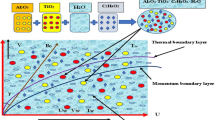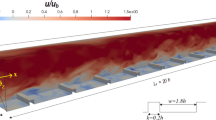Abstract
In this paper, the forced convective heat transfer enhancement with nanofluids in a 90° pipe bend has been presented. Numerical investigation is carried out for the turbulent flow through the pipe employing finite volume method. The governing differential equations are discretized using hexahedral cells, and the resulting algebraic equations are solved using Commercial solver Fluent 6.3. In order to close the time averaged Navier–Stokes equations, the two-equation k–ɛ turbulence model with a standard wall function have been used. The duct Reynolds number is varied in the range of 2,500–6,000. It is observed that the heat transfer is enhanced significantly by varying the volume fraction of the nanofluid. It is also found that the heat transfer is increased with Reynolds number. A strong secondary flow is observed due to the presence of the wall. Turbulent kinetic energy near outer wall is found to be higher than the inner wall of the bend. A comparative assessment for the heat transfer enhancement with different types of nanofluids is also presented. The computed results of area weighted average Nusselt numbers are validated with some of the existing literature.








Similar content being viewed by others
References
Bejan A and Lorente S 2001 Thermodynamic optimization of flow geometry in mechanical and civil engineering. J. Non-Equilibr. Thermodyn. 26: 305–354
Li Z, Mantel S C and Davidson J H 2005 Mechanical analysis of streamlined tubes with non–uniform wall thickness for heat exchangers. J. Strain Anal. Eng. Des. 40: 275–285
Najafi H and Najafi B 2000 Multi-objective optimization of a plate and frame heat exchanger via genetic algorithm. Heat Mass Transfer 46: 639–647
Ahuja A S 1975 Augmentation of heat transfer in laminar flow of polystyrene suspension. J. Appl. Phys. 46: 3408–3425
Liu K V, Choi S U S and Kasza K E 1998 Measurement of pressure drop and heat transfer in turbulent pipe flows of particulate slurries. Argonne National Laboratory Report ANL-88-15
Roco M C and Shook C A 1983 Modelling of slurry flow: the effect of particle size. Canadian J. Chem. Eng. 61:494–503
Sohn C W and Chen M M 1981 Microconvective thermal conductivity in dispersed two-phase mixture as observed in low velocity Couette flow experiment. J. Heat Transfer 103: 47–51
Choi S U S, Zhang Z G, Yu W, Lookwood F E and Grulke E A 2001 Anomalously thermal conductivity enhancement in nanotube suspension. Appl. Phys. Lett. 79: 2252–2254
Xuan Y and Li Q 2000 Heat transfer enhancement with nanofluids. Int. J. Heat Fluid Flow 21: 58–64
Wang X and Majumdar A S 2007 Heat transfer characteristics of nanofluids: A review. Int. J. Therm. Sci. 46: 1–19
Kakaç S and Pramuanjaroenkij A 2009 Review of convective heat transfer enhancement with nanofluids. Int. J. Heat Mass Transfer 52: 3187–3196
Xuan Y and Roetzel W 2000 Conceptions for heat transfer correlation of nanofluids. Int. J. Heat Mass Transfer 43: 3701–3707
Roy G, Nguyen C T and Lajoje P 2004 Numerical investigation of laminar flow and heat transfer in a radial flow cooling system with use of nanofluids. Superlattices Microstruct. 35: 497–511
Palm S J, Roy G and Nguyen C T 2006 Heat transfer enhancement with the use of nanofluids in radial flow cooling systems considering temperature-dependent properties. Appl. Therm. Eng. 26: 2209–2218
Boungiorno J 2006 Convective transport in nanofluids. J. Heat Transfer 128: 240–250
Rostamani M, Hosseinizadeh S F, Gorji M and Khodadadi J M 2010 Numerical study of turbulent forced convection flow of nanofluids in a long horizontal duct considering variable properties. Int. Commun. Heat Mass Transfer 37:1426–1431
Anoop K B, Sundararajan T and Das S K 2009 Effect of particle size on the convective heat transfer in nanofluid in the developing region. Int. J. Heat Mass Transfer 52: 2189–2195
Heris S Z, Esfahany M N and Etemad S G 2007 Experimental investigation of convective heat transfer of Al2O3/water nanofluid in circular tube. Int. J. Heat Mass Transfer 28: 203–210
Wen D and Ding Y 2004 Experimental investigation into convective heat transfer of nanofluids at entrance region under laminar flow conditions. Int. J. Heat Mass Transfer 47: 5181–5188
Heris S Z, Etemad S G and Esfahany M N 2006 Experimental investigation of oxide nanofluids laminar flow convective heat transfer. Int. Commun. Heat Mass Transfer 3: 529–535
Seyf H R and Feizbakhshi M 2012 Computation analysis of nanofluid effects on convective heat transfer enhancement of micro-pin-fin heat sinks. Int. J. Therm. Sci. 58: 168–179
Nazififard M, Nematollahi M, Jafarpur K and Suh K Y 2012 Numerical simulation of water-based alumina nanofluid in sub-channel geometry. Sci. Technol. Nucl. Installat. doi:10.1155/2012/928406
Bianco V, Chiacchio F, Manca O and Nardini S 2009 Numerical investigation of nanofluids forced convection in circular tubes. Appl. Therm. Eng. 29: 3632–3642
Heris S Z, Nassan T H, Noie S H, Sardarabadi H and Sardarabadi H 2013 Laminar convective heat transfer of Al2O3/water nanofluid through square cross section duct. Int. J. Heat Fluid Flow 44: 375–382
Lotfi R, Saboohi Y and Rashidi A M 2010 Numerical study of forced convective heat transfer heat transfer of nanofluids: Comparison of different approaches. Int. Commun. Heat Mass Transfer 37: 74–78
Azari A, Kalbasi M and Rahimi M 2014 CFD and experimental investigation on the heat transfer characteristics of alumina nanofluids under the laminar regime. Braz. J. Chem. Eng. 31: 469–481
Maiga S E B, Palm S J, Nguyen C T, Roy G and Galanis N 2005 Heat transfer enhancement by using nanofluids in forced convection flows. Int. J. Heat Fluid Flow 26: 530–546
Launder B E and Spalding D B 1974 The numerical computation of turbulent flows. Comput. Meth. Appl. Mech. Eng. 3: 269–279
Barik A K, Dash S K and Guha A 2015a Experimental and numerical investigation of air entrainment into an infrared suppression device. Appl. Therm. Eng. 75: 33–44
Barik A K, Dash S K and Guha A 2015b Entrainment of air into an infrared suppression device (IRS) using circular and non-circular multiple nozzles. Comput. Fluids 114: 26–38
Choi J and Zhang Y 2012 Numerical simulation of laminar forced convective heat transfer of Al2O3-water nanofluid in a pipe with return bend. Int. J. Therm. Sci. 55: 90–102
Akbarinia A and Behzadmehr A 2007 Numerical study of laminar mixed convection of nanofluid in horizontal curved tubes. Appl. Therm. Eng. 27: 1327–1337
Pak B C and Cho Y I 1998 Hydrodynamic and heat transfer study of dispersed fluids with submicron metallic oxide particles. Exper. Heat Transfer 11: 151–170
Maiga S E B, Nguyen C T, Galanis N and Roy G 2004 Heat transfer behaviours of nanofluids in a uniformly heated tube. Superlattices Microstruct. 35: 543–557
Lee S, Choi S U S, Li S and Eastman J A 1999 Measuring thermal conductivity of fluids containing oxide nanoparticles. J. Heat Transfer 121: 280–289
Mansour R B, Galanis N and Nguyen C T 2007 Effect of uncertainties in physical properties on forced convection heat transfer with nanofluids. Appl. Therm. Eng. 27: 240–249
Muralidhar K and Biswas G 2005 Advanced engineering fluid mechanics. Norosa Publishing House, New Delhi
Chakraborty G 2008 A note on methods for analysis of flow through microchannels. Int. J. Heat Mass Transfer 51: 4583–4588
Chandratilleke T T and Nursubyakto 2003 Numerical prediction of secondary flow and convective heat transfer in externally heated curved rectangular ducts. Int. J. Therm. Sci. 42: 187–198
Abdolbaqi M K, Azwadi C S N and Mamat R 2014 Heat transfer augmentation in the straight channel by using nanofluids. Case Stud. Therm. Eng. 3: 59–67
Author information
Authors and Affiliations
Corresponding author
Rights and permissions
About this article
Cite this article
Barik, A.K., Satapathy, P.K. & Sahoo, S.S. CFD study of forced convective heat transfer enhancement in a 90° bend duct of square cross section using nanofluid. Sādhanā 41, 795–804 (2016). https://doi.org/10.1007/s12046-016-0507-6
Received:
Revised:
Accepted:
Published:
Issue Date:
DOI: https://doi.org/10.1007/s12046-016-0507-6




